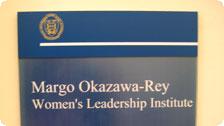by Stephanie Block
Dr. Margo Okazawa-Rey is not messing around. She and her international team have nominated one thousand women for 2005’s Nobel Peace Prize. A grand; one large; a ‘g.’
Dr. Okazawa-Rey is the coordinator for her corner of the world, mega-powers like the United States and Canada, as well as South Korea (where she was a Fulbright Scholar) and Japan. And when she’s not diving for Divas in these awesome nations, she directs the Women’s Leadership Institute at Mills College and is a professor of Women’s Studies.
Thanks to the work of her and others at 1000 Women for the Nobel Peace Prize 2005 (www.1000peacewomen.org), Dr. Wangari Maathai, winner of the 2004 Nobel Peace Prize, will be no anomaly. Did you know that in over a hundred years, only 12 women have won this prize?
Exactly. I caught up to Dr. Okazawa-Rey one morning in her office at Mills College in Oakland, California. The college’s female-only student body was fanning out across the lush campus in between classes, and some came ducking into women’s studies classes in stately Mills Hall. Dr. Okazawa-Rey invited me to sit with her around a big wooden table. She was dressed casually and acted casually, and I had to keep reminding myself that I was sitting across from an international dynamo activist!
The idea of 1000 Women for the Nobel Peace Prize 2005 was conceived by Swiss Diva Dr. Ruth-Gaby Vermot-Mangold (no, not that Dr. Ruth). In working with refugees around the world, she realized that it is often WOMEN who do the essential and dangerous work in zones of serious strife, and that the outside world rarely hears about these daily victories. She writes that, “People from countries at peace must render visible the concrete work for peace done by women.” Work like caring for orphans, finding food and clean water, planting trees, and holding peaceful vigils.
The fight for women to gain visibility in the Nobel Peace Prize process is a war of words, a rhetorical imperative that seeks to broaden the very definition of peace so that it lends itself to traditionally female spheres. Peace is won on many fronts far and above armed conflicts. The thousand women nominated this year are thus a collective, a vigil in itself to bring awareness to the life-giving work of women. The slate was submitted in February. In May, the women’s names will be announced. Stay tuned to Tango Diva- we will celebrate them!
Dr. Okazawa-Rey spoke about Dr. Maathai’s nomination, which clearly shows that the definition of peace HAS been broadened to include environmental activism. This broadening is “critical” for women and their future role in the Nobel Peace Prize. For more information about Dr. Wangari Maathai, please visit Tango Diva’s Diva Visionaries section.
In closing, I was able to ask Dr. Okazawa-Rey some of our standard Visionary Diva questions. Can you believe that she came up with these inspiring answers off the top of her head? What a Diva!
1. What was the best decision you made in your life?
Dr. O-R: I didn’t get married at the age of 17 or 18. I went to college.
2. What is your most memorable travel moment?
Dr. O-R: When I went to Palestine and Israel and the Occupied Territories, I was able to see the impact of U.S. foreign policy and the impact of occupation on the Palestinian people, and the relation between the two. I saw the mundane and banal manifestations of occupation. It really wears people down. The everyday becomes traumatic, like continually crossing checkpoints and rerouting around the wall.
3. What was your worst travel moment?
Dr. O-R: It was just the other day! I was at Laguardia in New York. I got a boarding pass and checked in my luggage. I sat waiting for an hour for my flight. When it finally came time to board, they kicked me off the flight saying that I had no ticket. This delayed me twelve hours. I couldn’t believe it! And what was even more frustrating was that my travel day had started the day before. I was supposed to fly out of Arcata, a small town in Northern California. But the airport was so fogged in that I had no choice but to drive eight hours down the coast to try to fly out of SFO. I was lucky to get on this red-eye, but after all that, I was told my ticket wasn’t valid. Talk about a long day!
4. If you could choose your ultimate travel companion, living or dead, real or imaginary, who would it be?
Dr. O-R: What a wonderful question. It would have to be someone who shares my political perspective and values, who is flexible, has a sense of humor and adventure, and who speaks several languages that I can’t. Someone who is generous and kind, who sees the aim of travel as broadening horizons but also understands what our own connections are to the people we meet and how we can make the world a better place.
5. If time and money were no object, where on earth would you go?
Dr. O-R: Everywhere: South America, Central America, Southeast Asia.
6. Who is your hero or heroes?
Dr. O-R: Congresswoman Barbara Lee, Betita Martinez, Young Nim Yu, Gwyn Kirk, Maha Abu-Dayyeh, and my mother.
7. Give us a stirring, Diva-worthy battle cry for women everywhere to hear!
Dr. O-R: If we can’t imagine it, we can’t have it, so let’s let our imaginations run wild and get on with it.
YES! And for more information on this amazing organization, please visit www.1000peacewomen.org.






